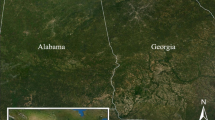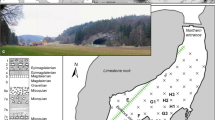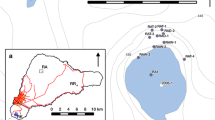Abstract
The δ13C values of 23 unevenly spaced guano samples from a 17-cm long clay sediment profile in Gaura cu Muscă Cave (GM), in SW Romania, made it possible to preliminarily characterize the Medieval Warm Period summer hydroclimate regime. The beginning of the sequence (AD 990) was rather wet for more than a century, before becoming progressively drier. After a brief, yet distinct wet period around AD 1170, drier conditions, with a possible shift from C3 to a mixed C3-dominated/C4 type vegetation (2 ‰ lower δ13C values), prevailed for almost half a century before the climate became colder and wetter at the onset of the Little Ice Age, when bats left the cave. The guano-inferred wet and dry intervals from the GM Cave are mirrored by changes in the color and amount of clay accumulated in the cave. They also agree well with reconstructions based on pollen and charcoal from peat bogs and δ13C and δ18O on speleothems from other Romanian sites. Overall, these results indicate that the δ13C of bat guano can provide a sensitive record of the short-term coupling between local/regional climate and the plant–insect–bat–guano system.


Similar content being viewed by others
References
Bird MI, Boobyer EM, Bryant C, Lewis HA, Paz V, Stephens WE (2007) A long record of environmental change from bat guano deposits in Makangit Cave, Palawan, Philippines: Earth and Environmental Science Transactions of the Royal Society of Edinburgh 98:59–69
Boecklen WJ, Yarnes CT, Cook BA, James AC (2011) On the use of stable isotopes in trophic ecology. Annu Rev Ecol Evol Syst 42:411–440
Boroneanţ V (2000) The archeology of the Romanian’s caves and mines. cIMeC, Bucharest, p 327 (in Romanian)
Boşcaiu N, Lupşa V (1967a) Palynological studies in Veterani Cave, Danube Gorge. Contribuţii Botanice: 39–46 (in Romanian)
Boşcaiu N, Lupşa V (1967b) Palynological research in the “Grota Haiducilor” Cave near the Herculaneum Spa (Romania). Rev Roum Biol Botanique 12(2–3):137–140
Boşcaiu N, Resmeriţă I (1969) Xerophylous herbaceous vegetation of the Eşelniţa-Mraconiei valleys alluvia in the Danube Gorge. Stud Cerc Biol Seria Bot 21(3):209–216 (in Romanian)
Boşcaiu N, Lupşa V, Boroneanţ V (1971) Sporo-pollen analysis of sediment in Climente Cave (Danube Gorge). St Cerc Biol Ser Bot 23(5):401–403 (in Romanian)
Botoșăneanu L, Negrea A, Negrea Ș (eds) (1967) Recherches sur les grottes du Banat et l’Oltenie, Roumanie (1959-1962). Centre National de la Recherche Scientifique, Paris, p 392
Brand WA, Geilmann H, Crosson ER, Rella CW (2009) Cavity ring-down spectroscopy versus high-temperature conversion isotope ratio mass spectrometry; a case study on δ2H and δ18O of pure water samples and alcohol/water mixtures. Rapid Commun Mass Spectrom 23:1879–1884
Bui-Thi M, Girard M (2000) Les guanos de chauve-souris d’âge médiéval de la Grande Grotte d’Arcy-sur-Cure (Yonne). Analyse pollinique et implications paléobotaniques. Géologie Alpine Mémoire HS 31:83–95
Büntgen U, Tegel W, Nicolussi K, McCormick M, Frank D, Trouet V, Kaplan JO, Herzig F, Heussner K-U, Wanner H, Luterbacher J, Esper J (2011) 2500 Years of European climate variability and human susceptibility. Science 331:578–582
Busch KW, Busch MA (1999) Cavity-ringdown spectroscopy: an ultratrace-absorption measurement technique. American Chemical Society, Washington, p 269
Carbonnel JR, Olive P, Decu VG, Klein D (1999) Datation d’un dépôt de guano holocène dans la Carpates méridionales (Roumanie), Implications tectoniques. CR Acad Sci Paris 328:367–370
Carrión JS, Scott L, Marais E (2006) Environmental implications of pollen spectra in bat droppings from southeastern Spain and potential for palaeoenvironmental reconstructions. Rev Palaeobot Palynol 140:175–186
Cerling TE, Harris JM, MacFadden BJ, Leakey MG, Quade J, Eisenmann V, Ehleringer JR (1997) Global vegetation change through the Miocene-Pliocene boundary. Nature 389:153–158
Coles GM, Gilbertson DD, Hunt CO, Jenkinson RDS (1989) Taphonomy and the palynology of cave deposits. Cave Sci 16:83–89
Constantin S, Onac BP, Fleitmann D, Tamas T (2001) Past vegetation changes in karst areas as revealed by a comparative isotopic study of two Holocene speleothems from Romania. In: Cheng Z, Changhong Y, Fong G (eds) World Correlation of Karst Ecosystems Newsletter. IGCP Project 448, Karst Dynamics Laboratory, Guilin, pp 67–73
Constantin S, Bojar A-V, Lauritzen S-E, Lundberg J (2007) Holocene and Late Pleistocene climate in the sub-Mediterranean continental environment: a speleothem record from Poleva Cave Southern Carpathians, Romania. Palaeogeogr Palaeoclim Palaeoecol 243:322–338
Decu V, Murariu D, Gheorghiu V (2003) The bats of Romania. Institutul de Speologie “Emil Racoviţă” şi Muzeul de Istorie Naturală “Grigore Antipa”, Bucureşti, p 521 (in Romanian)
DeNiro MJ, Epstein S (1978) Influence of diet on the distribution of carbon isotops in animals. Geochim Cosmochim Acta 42:495–506
Des Marais DJ, Mitchell JM, Meinschein WG, Hayes JM (1980) The carbon isotope biogeochemistry of the individual hydrocarbons in bat guano and the ecology of the insectivorous bats in the region of Carlsbad, New Mexico. Geochim Cosmochim Acta 44:2075–2086
Diaconu G, Dumitraş D (2000) Sur la présence de l’ardéalite dans la Grotte de Topolnita (Plateau de Mehedinti, Roumanie). Theor Appl Karstol 13–14:67–73
Dumitrescu M, Tanasacche J, Orgidan T (1962–1963) The distribution of bats in R.P.Română, Lucr Inst Speo “Emil Racoviţă” 1–2:509–576 (in Romanian)
Dykes AP (2007) Mass movements in cave sediments: geotechnical investigation of a 42,000-year old guano mudflow inside Niah Great Cave, Sarawak, Borneo. Landslides 4:279–290
Feurdean A, Spessa A, Magyari EK, Willis KJ, Veres D, Hickler T (2012) Trends in biomass burning in the Carpathian region over the last 15,000 years. Quat Sci Rev 45:111–125
Forbes MS, Bestland EA (2006) Guano-derived deposits within the sandy cave fills of Naracoorte, South Australia. Altering. Australas J Palaeontol 30:129–146 (special issue 1)
Gavin DG (2001) Estimation of inbuilt age in radiocarbon ages of soil charcoal for fire history studies. Radiocarbon 43(1):27–44
Geantă A, Tanţău I, Tămaș T, Johnston V (2012) Palaeoenvironmental information from the palynology of an 800 year old bat guano deposit from Măgurici Cave, NW Transylvania (Romania). Rev Palaeobot Palynol 174:57–66
Gilbertson DD, Bird M, Hunt C, McLaren S, Mani Banda R, Pyatt B, Rose J, Stephens M (2005) Past human activity and geomorphological change in a guano-rich tropical cave mouth: initial interpretations of the Late Quaternary succession in the Great Cave of Niah, Sarawak. Asian Perspect 44(1):16–41
Harris AH (1979) Reconstruction of mid-Wisconsin environments in southern New Mexico. Natl Geogr Res 3:142–151
Hock RJ (1951) The metabolic rates and body temperatures of bats. Biol Bulletin 101:289–299
Johnston VE, McDermott F, Tămaș T (2010) A radiocarbon dated bat guano deposit from N.W. Romania: implications for the timing of the Little Ice Age and Medieval Climate Anomaly. Palaeogeogr Palaeoclimatol Palaeoecol 291:217–227
Kennedy RA, Laetsch WM (1974) Plant Species Intermediate for C3, C4 Photosynthesis. Science 184:1087–1089
Kohn MJ (2010) Carbon isotope compositions of terrestrial C3 plants as indicators of (paleo)ecology and (paleo)climate. PNAS 107:19691–19695
Kunz TH, Murray SW, Fuller NW (2012) Bats. In: White WB, Culver DC (eds) Encyclopedia of Caves. Academic Press, Oxford, pp 40–54
Leroy SAG, Simms MJ (2006) Iron age to medieval entomogamous vegetation and Rhinolophus hipposideros roost in South-Eastern Wales (UK). Palaeogeogr Palaeoclimatol Palaeoecol 237:4–18
Maher LJJ (2006) Environmental information from guano palynology of insectivorous bats of the central part of the United States of America. Palaeogeogr Palaeoclimatol Palaeoecol 237:19–31
Marincea Ș, Dumitraș DG, Diaconu G, Bilal E (2004) Hydroxylapatite, brushite and ardealite in the bat guano deposit from Pestera Mare de la Meresti, Persani Mountains, Romania. N Jb Miner Mh 10:464–488
Marusek JA (2010) A chronological listing of early weather events. Science & Public Policy Institute, Reprint Series, p 580
Matacă SȘ (2003) Porțile de Fier Natural Park. Flora, vegetation, and nature protection. Unpubl. PhD Thesis, Romanian Academy, Institute of Biology, Bucharest
McFadgen BG (1982) Dating New Zealand archaeology by radiocarbon. NZ J Sci 25:379–392
McFarlane DA, Lundberg J, Fincham AGA (2002) Late Quaternary paleoecological record from caves of southern Jamaica: West Indies. J Cave Karst Stud 64:117–125
Méhely L (1900) Monographia Chiopterorum Hungariae. Budapest, p 372
Mizutani H, McFarlane DA, Kabaya Y (1992a) Nitrogen and carbon isotope study of a bat guano core from Eagle Creek Cave, Arizona, USA. Mass Spectrosc 40:57–65
Mizutani H, McFarlane DA, Kabaya Y (1992b) Carbon and nitrogen isotopic signatures of bat guanos as a record of past environments. Mass Spectrosc 40:67–82
Munteanu R, Bălănescu D (1999) Air and rainfall temperature regime in the space of Banat in the year 1997. Proc Regional Conf of Geography “Danube-Criș-Mureș-Tisa Euroregion-Geoeconomical space of sustainable development”. West University, Timișoara, pp 141–155
Negrea A, Negrea Ș (1979) The caves of the Danube Gorge and their terrestrial fauna. In: Orghidan T, Negrea Ș (eds) Speologia. Academiei RSR, București, pp 30–75 (in Romanian)
O’Leary MH (1981) Carbon isotope fractionation in plants. Phytochemistry 20:553–567
Onac BP, Bengeanu M (1992) Phosphate minerals in few caves from Padurea Craiului Mountains (Romania)—Preliminary note. Nymphaea XXII:23–28
Onac BP, Vereș DȘ (2003) Sequence of secondary phosphate deposition in a karst environment: evidence from Magurici Cave (Romania). Eur J Mineral 15:741–745
Onac BP, Constantin S, Lundberg J, Lauritzen SE (2002) Isotopic climate record in a Holocene stalagmite from Urșilor Cave (Romania). J Quat Sci 17:319–327
Onac BP, Zaharia L, Kearns J, Vereș DȘ (2006) Vashegyite from Gaura cu Muscă Cave. Int J Speleol 35(2):67–73
Osmond CB, Allaway WG, Sutton BG, Troughton JH, Queiroz O, Luttge U, Winter K (1973) Carbon isotope discrimination in photosynthesis of CAM plants. Nature 246:41–42
Pons A, Quézel P (1958) Premières remarques sur l’étude palynologique d’un guano fossile du Hoggar, Compte Rendus Hebdomadaires des Séances de l’Académie des Sciences 246: 2290–2293
Pop E, Boşcaiu N, Lupşa V (1970) Spoor-pollen analysis of sediments from Cuina Turcului—Dubova. St cerc ist veche 21(1):31–34 (in Romanian)
Reimer PJ, Baillie MGL, Bard E, Bayliss A, Beck JW, Blackwell PG, Bronk Ramsey C, Buck CE, Burr GS, Edwards RL, Friedrich M, Grootes PM, Guilderson TP, Hajdas I, Heaton TJ, Hogg AG, Hughen KA, Kaiser KF, Kromer B, McCormac FG, Manning SW, Reimer RW, Richards DA, Southon JR, Talamo S, Turney CSM, van der Plicht J, Weyhenmeyer CE (2009) IntCal09 and Marine09 radiocarbon age calibration curves, 0–50, 000 years cal BP. Radiocarbon 51:1111–1150
Rösch M, Fischer E (2000) A radiocarbon dated Holocene profile from the Banat mountains (Southwestern Carpathians, Romania). Flora 195:277–286
Sandu I, Pescaru VI, Poiană I (eds) (2008) The climate of Romania. Editura Academiei Române, București, p 365 (in Romanian)
Sasowsky ID, Mylroie J (2007) Studies of cave sediments. Physical and chemical records of paleoclimate. Springer, Berlin, p 340
Smith BN, Epstein S (1971) Two categories of 13C/12C ratios for higher plants. Plant Physiol 47:380–384
Waldbauer GP, Friedman S (1991) Self-selection of optimal diets by insects. Ann Rev Entomol 36:43–63
Waterbolk HT (1983) Ten guidelines for the archaeological interpretation of radiocarbon dates. In: Mook WG, Waterbolk HT (eds) Proc 1st Int Symp 14C Archaeology, Groningen 1981, PACT8:57–70
White WB (2007) Cave sediments and paleoclimate. J Cave Karst Stud 69:76–93
Wurster CM, McFarlane DA, Bird MI (2007) Spatial and temporal expression of vegetation and atmospheric variability from stable carbon and nitrogen isotope analysis of bat guano in the southern United States. Geochim Cosmochim Acta 71:3302–3310
Wurster CM, Patterson WP, McFarlane DA, Wassenaar LI, Hobson KA, Athfield NB, Bird MI (2008) Stable carbon and hydrogen isotopes from bat guano in the Grand Canyon, USA, reveal Younger Dryas and 8.2 ka events. Geology 36:683–686
Wurster CM, McFarlane DA, Bird MI, Ascough P, Ashfield NB (2010) Stable isotopes of subfossil bat guano as a long-term environmental archive: insights from a Grand Canyon cave deposit. J Cave Karst Stud 72(2):111–121
Zahn A, Haselbach H, Güttinger R (2005) Foraging activity of central European Myotis myotis in a landscape dominated by spruce monocultures. Mammalian Biol 70:265–270
Acknowledgments
The authors thank the administration of the Porţile de Fier Natural Park for granting permission to recover the guano/clay profile from Gaura cu Muscă Cave. Special thanks to Dr. I. Coroiu for discussing the aspects of bat ecology with the authors. This research was funded by CNCS grant PN-II-ID-PCE 2011-0-0588 to BPO.
Author information
Authors and Affiliations
Corresponding author
Rights and permissions
About this article
Cite this article
Onac, B.P., Forray, F.L., Wynn, J.G. et al. Guano-derived δ13C-based paleo-hydroclimate record from Gaura cu Musca Cave, SW Romania. Environ Earth Sci 71, 4061–4069 (2014). https://doi.org/10.1007/s12665-013-2789-x
Received:
Accepted:
Published:
Issue Date:
DOI: https://doi.org/10.1007/s12665-013-2789-x




